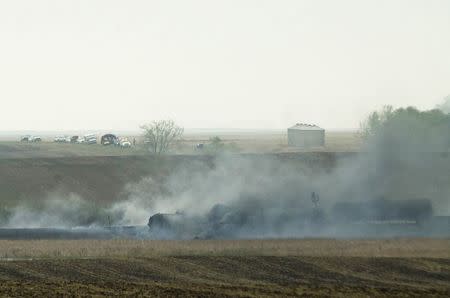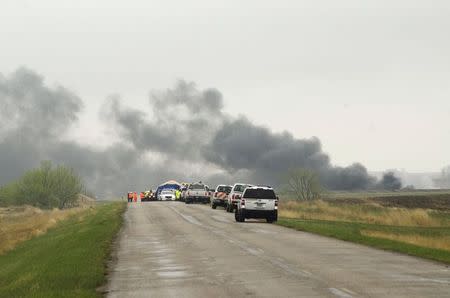Exclusive: Oil on fiery North Dakota train less volatile than limit
By Ernest Scheyder WILLISTON, N.D. (Reuters) - Crude oil aboard a BNSF train that derailed in North Dakota on Wednesday caught fire even though it was less flammable than required by a state law that took effect last month. Test results sent to federal investigators and seen by Reuters show the state's new rule may not be stringent enough to significantly reduce the risks of fireballs after derailments of trains carrying crude. In this crash, the crude on board contained about 20 percent fewer volatile gases than regulations mandate. The oil, transported in tank cars owned by Hess Corp, had a vapor pressure of 10.83 psi, according to test results. This pressure is less than the new threshold of 13.7 psi. State regulators have used vapor pressure as a proxy for measuring the amount of flammable gases known as light-ends that are present in crude. Samples of the crude oil involved in this latest derailment were taken on May 5 at the Tioga rail complex owned by Hess. They were tested on May 6, the day of the accident, by Intertek, a diagnostics firm, according to the document, which was supplied to the Federal Railroad Administration. No one was injured on Wednesday morning when six of the 109 cars derailed, four of which burned. Forty residents were evacuated from the nearby town of Heimdal and allowed to return home by late evening. Critics of the new safety rules have said they do little to stop so-called "Bakken Bombs," a pejorative for crude-by-rail transport in the state's Bakken oil patch, and should be far tougher. State officials said they said they were pleased that the aftermath of the Heimdal derailment was far less devastating than previous crashes. "The fact that we're down at 10.8 psi is a good sign that what we implemented is working," said Doug Goehring, North Dakota's agriculture commissioner and one of three members of the state's Industrial Commission, which crafted the rules. "I'm happy with the condition of the oil in those tankcars, with the oil out in the field and the oil leaving North Dakota." NEW FEDERAL RULES Meanwhile, the U.S. Department of Transportation, following earlier moves by Canada, last week announced new rules to require shippers to use stronger tank cars to carry crude, among other new requirements, in order to reduce the risks of punctures and fires. Those DOT rules, while encouraging crude testing and sampling, stopped short of introducing new vapor pressure rules. But they do require protection for pressure relief valves on railcars. The valves relieve pressure in the event of a fire or impact. Experts said during routine transport pressure would never hit the 75 psi level that activates them. "The function is if there is an excessive buildup of pressure," said Patrick Ameen of Amsted Rail, which provides wheels, axles and other equipment to the rail industry. Even as they enforce the new rules, Industrial Commission members said they consider them just part of a package of solutions needed to curb disasters involving transport of crude by rail, which have increased sharply in number in recent years. Shippers, for their part, have blamed track failures for the rash of recent crashes in the United States and Canada. BNSF is spending $400 million to replace 110 miles (180 km) of aging track in North Dakota. Alongside much of the company's rail in the western part of the state, bulldozers and other heavy machinery have been working for weeks to repair and replace the lines. (Additional reporting by Kristen Hays in Houston)


